 To get to Arequipa from Cuzco the options are a US$12 bus trip that takes 18 hours over very bad roads, a two phase train trip via Juliaca near Lake Titicaca for US$22 or a hour long flight for US$55. An hour later we landed in Arequipa.
To get to Arequipa from Cuzco the options are a US$12 bus trip that takes 18 hours over very bad roads, a two phase train trip via Juliaca near Lake Titicaca for US$22 or a hour long flight for US$55. An hour later we landed in Arequipa.
| Arequipa | Monastery | Colca Canyon |
The southern highlands is considered part of the gringo trail of visiting Peru. Lake Titicaca is often part of the visit but we decided to skip it, so many places so little time.
 To get to Arequipa from Cuzco the options are a US$12 bus trip that takes 18 hours over very bad roads, a two phase train trip via Juliaca near Lake Titicaca for US$22 or a hour long flight for US$55. An hour later we landed in Arequipa.
To get to Arequipa from Cuzco the options are a US$12 bus trip that takes 18 hours over very bad roads, a two phase train trip via Juliaca near Lake Titicaca for US$22 or a hour long flight for US$55. An hour later we landed in Arequipa.
At over one million people, Arequipa is Peru's second largest city although people in Trujillo might argue differently. At 2325 metres it is a city of the western Andes but its well connected by road to Peru's south coast. The city is surrounded by mountains including the snow capped volcano El Misti. There are two possible sources for the city name; Aymara Indians called the area Ariquepa "the place behind the pointed mountain" or another legend is that the Inca Mayta Capac ordered his entourage to stop with the words "Ari quipay" which is "Yes, stop" in Quechua.
The city was totally destroyed by earthquakes and volcanic eruptions in 1600 and further damaged by earthquakes in 1687, 1868, 1958, 1960 and 2001. Despite these disasters many 17th and 18th century buildings survive. Many of the buildings are made from a light coloured volcanic rock called sillar giving the city the nickname 'The White City.'
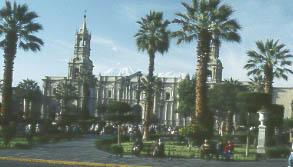
Like most communities in Peru the centre of town is the Plaza del Armas which contains the main cathedral which uses an entire side of the plaza. The massive twin towered cathedral is one of only 70 churches in the world that is allowed to fly the Vatican flag. Built in 1656 it was destroyed by fire in 1844 then badly damaged by an earthquake in 1868. On the plazas southeast corner is the Jesuit church of La Compañía with side porches that date from 1654. This solidly built church has an ornate main facade and survived earthquakes that have toppled other buildings. Another interesting church is San Francisco, mainly to see the large crack in the copola caused by an earthquakes and the view of El Misti from the balcony of the inner courtyard. There are also some religious paintings where you can see where people have tried to change Andean faces to European faces.
There are several inexpensive restaurants around the other three sides of the plaza which contain colonial arcaded buildings. Since Peru is the land of the potato there must be a 100 ways that potatoes are prepared, try some. Italian food has become very popular in Peru although sometimes with a distinctly Peruvian touch. There are also several cybercafes near the main plaza.
Even if you think you have seen enough churches and colonial buildings the Monastery of Santa Catalina is worth a visit. This is one of those "if you can only visit one place" type places.
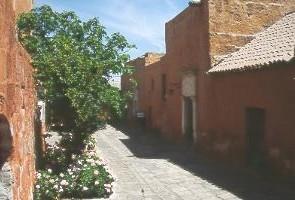 Actually a convent built in 1580 it only accepted nuns from the upper class families of Peru. All nuns had to pay a dowry, traditionally the second born daughter entered the nunnery to live a life of poverty and renounce the material world. In actuality each nun had one to four servants or slaves, invited musicians to play at the convent, had parties and generally lived in the style they were accustomed to while growing up. This all changed in 1871 when the pope sent a strict Dominican nun to run the convent. She sent the dowries to Europe and freed the servants and slaves. Surrounded by high walls the convent remained a mystery to the outside world until 1970 when it opened to the public to help pay for electricity and running water.
Actually a convent built in 1580 it only accepted nuns from the upper class families of Peru. All nuns had to pay a dowry, traditionally the second born daughter entered the nunnery to live a life of poverty and renounce the material world. In actuality each nun had one to four servants or slaves, invited musicians to play at the convent, had parties and generally lived in the style they were accustomed to while growing up. This all changed in 1871 when the pope sent a strict Dominican nun to run the convent. She sent the dowries to Europe and freed the servants and slaves. Surrounded by high walls the convent remained a mystery to the outside world until 1970 when it opened to the public to help pay for electricity and running water.
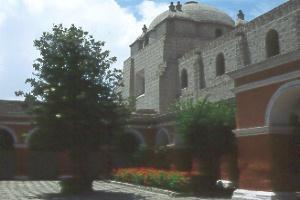
The convent is a city within a city, its covers an entire city block and is a complex of buildings, courtyards, and alleyways of 20,000 square metres. Changes in society that have affected the developed Catholic world have reached the developing Catholic world of Peru. In the past up to 450 nuns lived here, today 20 live a cloistered life in the northern corner of the complex. You might catch a glimpse of one as she runs across a plaza.
The site costs 12 sols to visit and there is a small on-site cafeteria where you can buy homemade snacks made by the nuns. The buildings have been beautiful restored and the small gardens are well tended so relax and remember to take plenty of pictures.
There are several excursions from Arequipa including hiking and mountain climbing but the most popular is a sightseeing trip to the Colca Canyon at 3,182 metres one of the world's deepest gorges. This trip will include visits to the Reserva Nacional Salinas y Aquada Blanca, views of extensive Inca and pre-Inca terraces, visits to several small villages, and possible sightings of condors at Cruz del Cóndor.
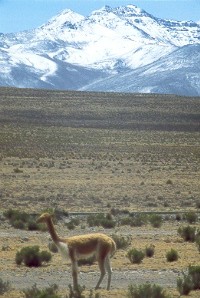
Most guided tours cost about the same unless you book a private tour with one of the expensive touring companies then the trip can cost up to three times more. Usually it does not matter who you book with since the companies will often pool their groups to fill the buses. We booked an overnight trip with Santa Catalina Tours for 107 sols which included a hotel and breakfast but no other meals. The trip can be done as a one day trip but you start very early and it will be rushed.
Most tour agencies will pick you up at your hotel. Only bring a daypack with you for an overnight trip, you can store your luggage at the hotel. Like in Cuzco most hotels in Arequipa offer luggage storage. We were one of the last people to be picked up and nightmare of nightmares the only available seats were right behind a family with three kids. One reason, of many, we travel in the off-season is to avoid kids. They were an Australian couple and their kids were remarkable well behaved, we have stayed in e-mail contact with them since.
The bus will pass Chachani volcano as it continues through the Reserva Nacional Salinas y Aquada Blanca, which covers over 350,000 hectares at an average elevation of 3850 metres. You will probably see vicuñas, a rare cameloid species which the locals sometimes capture, shear their wool then set free. The sweaters made from vicuñas wool is very expensive. Later in the day you will probably also see domesticated alpacas and llamas, so it is possible to see three of the four South American cameloid species in one day. The fourth species is the guanaco, rarely seen and endangered.

The tour bus will stop for a coca tea break at a truck stop before continuing through the antiplano. I noticed that many people seem to keep pet birds of prey in this area. I noticed one at the truck stop and several others later on. The highpoint on the antiplano is 4800 metres and it was snowing. Several people on the bus suffered from altitude sickness. The coca tea hopefully will lessen some of the effects but if your body has not adjusted to the thin air you will probably feel it.
Once you reach the highest point the road spectacularly drops to about 3700 metres as you enter the town of Chivay where you be spending the night if you are doing the overnight trip. Chivay is about 160 kilometres from Arequipa and you should arrive around 2PM depending on the number of stops your driver makes along the way.
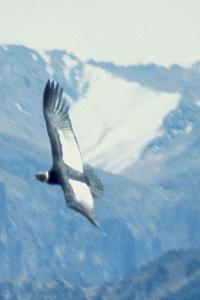
Chivay is an unassuming town where you can enjoy a visit to some thermal hot springs. If your not use to the attitude don't push your body too hard and avoid alcohol. I assumed I had adapted to the attitude so I had a beer during supper and got very weak for about 20 minutes.

After breakfast the bus will continue west along the south side of the upper Colca Canyon for about 60 km to reach the end point of the tour, Cruz del Cóndor. There will probably be several tour buses here full of people hoping to see the Andean condor. You probably will not be disappointed.
.The people living in this region are known for wearing beautifully embroidered clothes and you be visiting several small markets on your return from Cruz del Cóndor. The landscape is remarkable for the amount of Inca and pre-Inca (Collahuas) terracing which is still used today. You will probably visit the town of Yanque which contains a church from the early 1700's that was partially destroyed in an earthquake in the early 1990's. There was someone near the church with his pet hawk, for a small fee you could get your picture taken with his pet. You will probably return to Arequipa around 2 pm after several stops including a lunch stop.
Once you return from Colca Canyon it is possible to get a night bus or train out of Arequipa if you did not want to stay the night. A night train leaves for Juliaca which is near Lake Titicaca. Arequipa is one of the few towns with a central bus terminal and our next stop was Nazca. The night buses are very comfortable with reclining seats and if you want extra comfort there are special double decker night buses that have beds.
| Visit the Amazon Basin |
Visit Andean Peru |
Visit South Coast |
Visit the North Coast |
Return to Travel Page |
Return to Main Page |